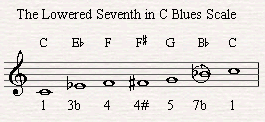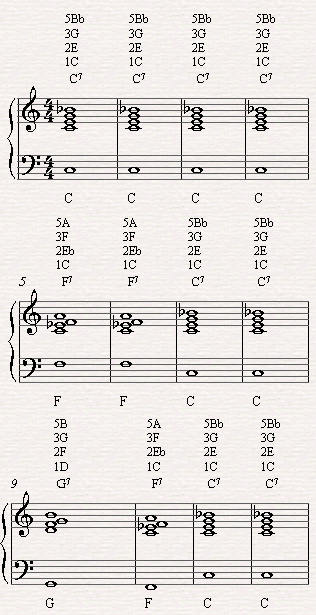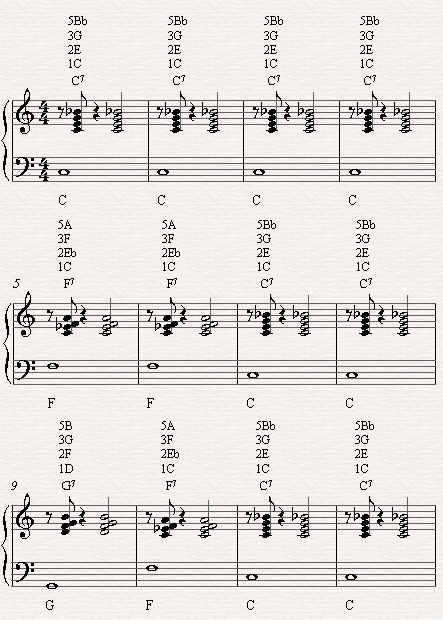Blues Chords
Home » Piano Chords »Blues Chords
Adding the Seventh Note to the Blues Chords

The blues scheme as we've seen it so far is not yet played in a bluesy way. We need to add a bluesy character
to each of the chords. When we discussed about the different seventh chords I told you that the seventh notes has to functions in music.
The first function (in major dominant chord) is to increase the tension of the chord toward the tonic or toward the next falling fifth (In case of the secondary dominants).

The second function is to provide color. This color can be certainly named a bluesy color for the seventh color derives from the lowered seventh of the blues note.

So what were going to do next is add the seventh color to each of the chords in the blues scheme.
By the way, it's true that the tonic gets the seventh note as well but it still remains as a tonic and doesn't function a dominant. The same applies to F7. These chords are real blues chords in this manner. Their seventh note is a blue note.
A Bluesy Groove
The blues can be played in many various ways. It is actually only a harmonic figure that can be put over many styles like jazz, rock or pop and is often inserted within these styles for its simplicity that makes it so catchy and since the blues is the father of all these styles.
One thing is certain though. The blues involves some interesting rhythmic figures. Although the blues can be played as a balled as well it should still involve some rhythmic interest. That's part of its African impact.
The most important rhythmic element that differentiates the blues from the European music was that the strong beats of the blues were the second and the fourth beats while the first and third beat were strong in the European music. That fact alone is creates a major groovy impact.
Here's an example of a handy bluesy groove.

Another remark about the bluesy groove; the blues groove should be played in a laid back way. It's hard to express this way of playing but what it really means is that when you accompany the blues chords you should play them a bit lazy; somewhat after the beat without making the tempo slowly. This example here demonstrates this clearly.
Alright, now that we know how to play the 12 bar blues with by grooving with the seventh chords we can learn about all the different possible chord progressions which can be added to the plain 12 bar blues scheme.

Now if you're into playing Blues Music you're probably also eager to play some gospel music. The problem is it's not easy to find a good teacher that experts Gospel music. Well. if you want to start playing ALL of your favourite hymns and Congregational songs by ear right away, I've definitely found something that's going to help you do just that.
While reading piano notes might take ages, this course teaches you how to play Gospel Music by ear with 3 simple steps (Determining the melody, harmonizing the melody then adding the bass) that are easy to follow and so you won't waste any time at all. Click here to check the Gospel Keys Piano Course Now!














